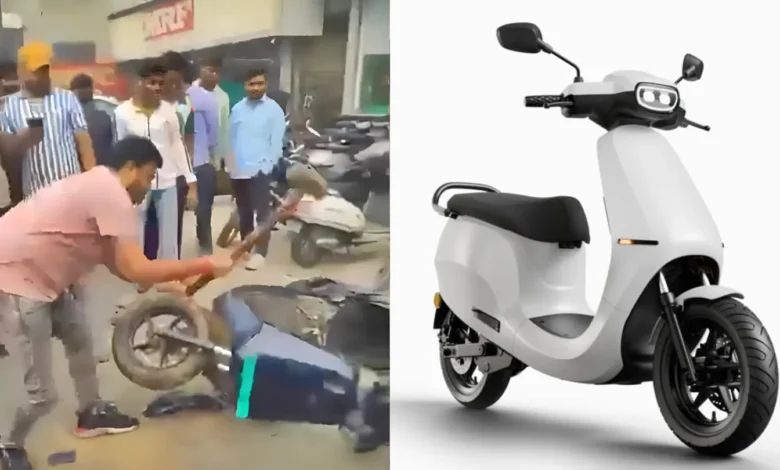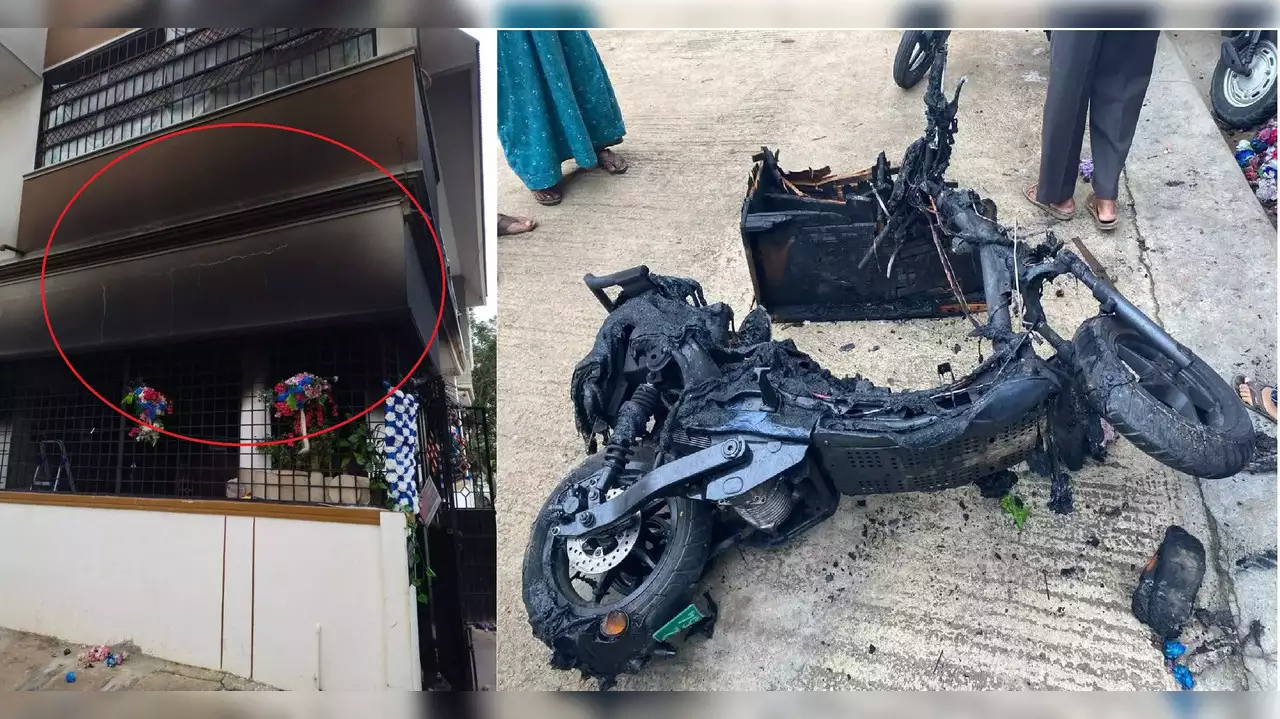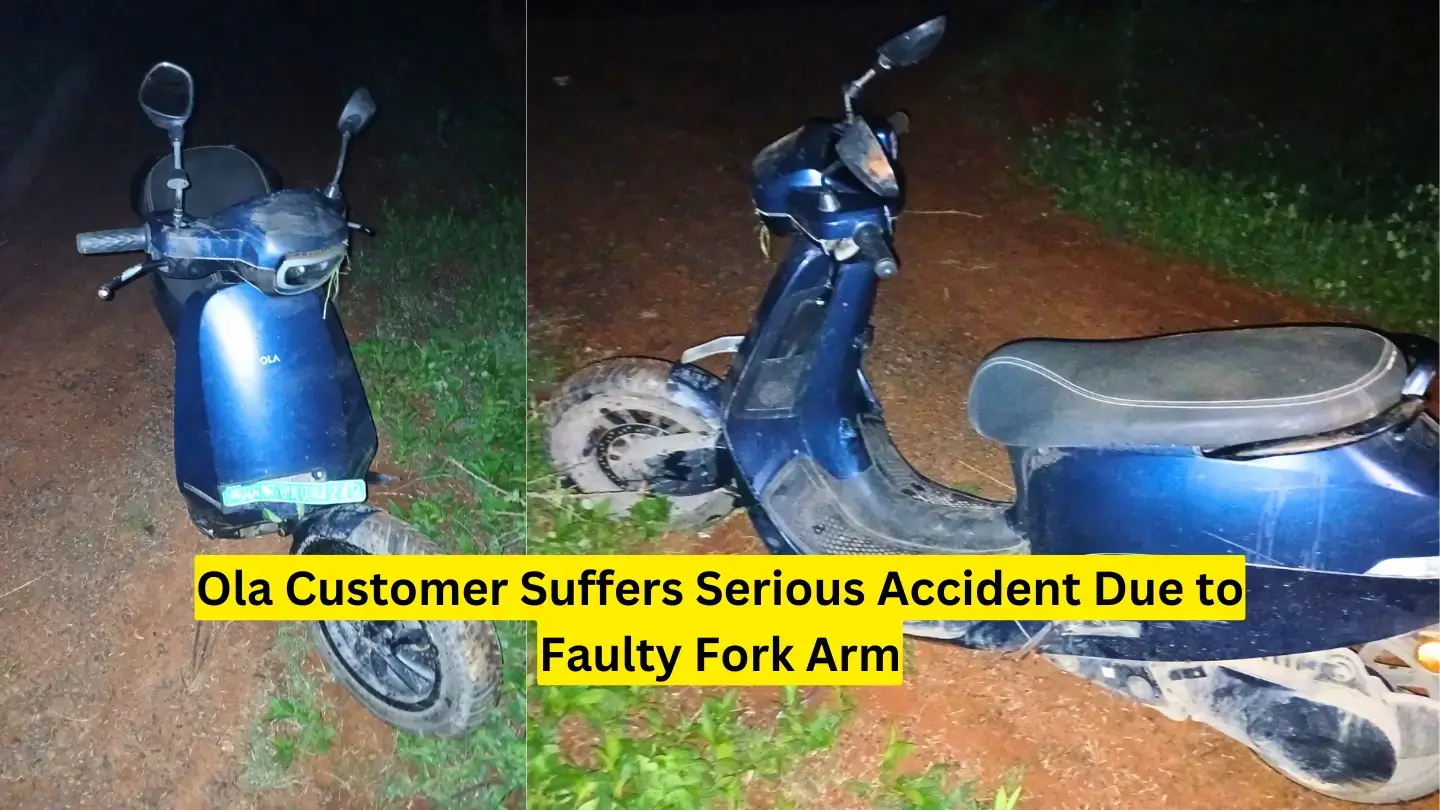₹90,000 Repair Bill Sparks Outrage. How Ola Electric’s Poor Service And Defective Scooters Are Turning Away Customers Across India?
A horrific incident surfaced on November 24, 2024, outside an Ola Electric showroom in India: a customer is seen battering his one-month-old Ola Electric scooter with a hammer. This destruction, locals said, was over an exorbitant repair bill the customer received that would cost him ₹90,000, or around $1,080. A video of the incident quickly went viral on social media, bringing into public attention debates about customer service and corporate accountability in the electric vehicle sector.

On November 24, 2024, a video of an irate customer smashing his newly bought Ola Electric scooter with a hammer in front of the company’s showroom went viral on social media. What frustrated the customer was the unexpected and excessively high repair bill amounting to ₹90,000 ($1,080) for a scooter he purchased barely a month back. The incident has sparked outrage and mixed reactions from many and raises important questions about Ola Electric’s products and after-sales service.
The Incident: A Customer’s Breaking Point
What Happened?
Inside a showroom of Ola Electric, a rather dramatic public show was witnessed when an angry customer resorted to wielding a hammer on his month-old Ola S1 scooter. Videographed and circulating across social media platforms, this showed the growing ire of the customer against the service and repair policies of Ola.
Dressed in a white T-shirt, the man began smashing the scooter with a hammer, venting his anger over a repair bill of ₹90,000—a figure that seems astronomical for a vehicle purchased just weeks earlier. His act was not lone; another person soon joined him and took their turns at the hammer, which was passed around to members of the growing crowd to watch it happen. The intensity of their actions underscored the customer’s exasperation with what he perceived as unjustified costs and inadequate support from the company.
The crowd ran amok as spectators, who themselves had grievances with Ola Electric, told it to sue or even burn down the scooter. This public destruction of a high-tech electric scooter outside a company showroom became an outburst, articulating deep grievances about Ola Electric’s products and services.
The Lead-Up to That Epic Event
According to him, being not satisfied with Ola’s response toward the repair issue, he tried resolution through the official channel.There, his attempt was faced with delay and vagueness such that he had little option but to pay the astronomical bill or to take a more drastic step. His destruction of the scooter just before the showroom wasn’t an emotional outburst; it was a well-calculated act meant to bring attention to his plight and many others like himself.
This is not a singular story but a part of a larger story of disappointment at Ola Electric. Complaints of no after-sales care, higher repair bills, and specific issues related to the products that tend to repeat themselves have made many wonder if the brand actually cares about the quality and service.
Public Reaction to the Incident
The video went viral on X (formerly Twitter) and Instagram, and since then, discussions on the issue have gotten pretty heated among the netizens.
Defending the Victim
Many sympathized with the customer, commending his acts as a form of resistance to what they described as exploitative corporate practices.
“This man is justified in being frustrated. Companies like Ola think that they can treat people the way they want,” one user wrote.
Another commented: “These repair costs are absurds. For some people, this is a livelihood on the line.”
Criticism of the Vandalism
Others were criticism of the action, such as destruction is not the solution to resolve issues over grievances.
“Why not file consumer complaint instead of damaging property?” argued one
Legal action would have had an impact on the issue-this does not solve anything, wrote another
Broader Concern Over EV Companies
Some comments came from a broader perspective regarding the electric vehicle (EV) market in relation to customer care for the companies.
“Every time I think of buying an Ola scooter, videos like this make me think twice,” posted a user.
“Indian EV makers need to get serious about quality. Otherwise, these companies will lose consumer trust completely,” said another.
And it’s not just about one man and his scooter—it became the symbol of growing discontent over Ola Electric and, to some extent, the EV industry in India. The dramatic scene outside the showroom brought into focus mounting dissatisfaction with the after-sales service of Ola, its issues of untrustworthiness, and many perceived predatory practices like unfounded repair costs.
It shows a fundamental issue: many consumers feel unheard, unconsidered, and not supported by companies that they invest significant amounts of money in. Whether this public outcry will spur meaningful change from Ola Electric remains to be seen, but it has undoubtedly brought more attention to the various challenges faced by EV consumers in India.
Customer Complaints with Ola Electric

A History of Complaints
Ola Electric, a subsidiary of ride-hailing giant Ola, entered the Indian electric vehicle market making huge promises and ambitious targets. Marked as a revolutionary step toward sustainable mobility, its initial products certainly generated significant excitement.
However, below the highly emblazoned advertisement and lofty claims, Ola Electric has been pegged by untiring criticism from its customers. Complaints about product quality, customer service, and after-sales support have dominated discussions of the company. Between September 2023 and November 2024 alone, the national Consumer Helpline recorded over 10,644 complaints against Ola Electric, which testifies to the frequency of discontent.
The complaints show some underlying issues with the functioning of Ola. The most obvious of these is the defective electric scooters it sells. Many complain that their vehicles keep malfunctioning often-for some, due to glitches in the software, untrustworthy batteries, or mechanical failures. Defects aside, such aberrations will not only inconvenience users but also raise more problems about the standards of quality control at the company’s end.
Another very common grievance pertains to time taken by rectification. Usually, customers are forced to spend too long in Ola service stations, with even minor rectifications taking weeks or months. For many customers, it just means being abandoned without having a working vehicle. Delays in rectification undermine trust and leave consumers questioning the company’s commitment to after-sales support.
Adding to the frustration is the matter of exorbitant repair costs. Customers have been surprised by astronomical bills for repairs, which are most often unrelated to the problem that prompted the ride. The latest viral incident-beating a scooter outside an Ola showroom after getting billed ₹90,000-is but one example of this trend. These shocks dent customer confidence about the price transparency and warranty guarantees at Ola, making them feel exploited.
Actual Cases
The grievances aired in the viral video are not one-off incidents. A more nuanced look at recorded customer cases presents a disturbing trend of persistent problems with Ola Electric products and services. These actual cases tell a more incisive story of the problems customers are finding to deal with.
Battery Failures
The most common grievances aired against Ola scooters appear to be the battery. A Pune resident bought the Ola S1 Pro scooter with high expectations, but his experience turned sour within weeks. During a long commute, it abruptly stopped operating and left him stranded on the roadside.
The company in its advertisement claimed that its batteries were strong and reliable, but the service centre held it responsible for “user misuse” and charged ₹25,000 for the replacement parts. This experience mirrors that of many other users who have faced sudden failure of their batteries, putting a question mark on Ola’s flagship product’s reliability.
Fire Hazards
Safety issues were scaled up in March 2024 after an Ola scooter caught fire in Chennai while parked. The incident created a nationwide alarm, especially when similar fires of electric scooters had been reported from various parts of the country. Ola Electric described the incident as an incident of an “external factor” and not provided compensation to the victim, which only enraged the victimized customer.
Independent analysts pointed fingers towards thermal management system deficiency in batteries, as their manufacturing was proved to be not on par. Such incidents have ultimately led to frustration on the part of the customers as they are neither safe nor taken proper care of.
Software Glitches
Besides hardware failures, most customers have complained about software glitches, which have severely affected usability. A Bengaluru-based technocrat was left in the lurch when her Ola S1 scooter developed dashboard issues within the first week of delivery.
The screen froze mid-ride, and she could not use all essential functions such as speed tracking and navigation. This problem did not get resolved even after three trips to the service center. Such glitches question the claims made by Ola of advanced technology and sound testing on products before their market launch.
Unprofessional Service Centers
Customer dissatisfaction is further compounded with shortcomings in the service network of Ola. A Hyderabad customer had experienced first hand the “humiliating experience” at an Ola service center. He had to visit the service center three times for the same recurring brake problem. And there was no solution provided.
To top it all, the staff even made him pay for unnecessary repairs and his bills were inflated without fixing his actual problem. This unprofessionalism and lack of accountability bring Ola’s after-sales infrastructure into disrepute.
Systemic issues within the operations at Ola Electric unfold through these real-life stories. These three critical areas where the company failed to deliver upon customers’ expectations are product reliability, after-sales service, and accountability. While Ola made big promises, it failed miserably in delivering a dependable product, and service centers prove to be grossly inadequate in resolving issues efficiently or showing respect to customers.
Ola Electric’s Response

Corporate Reactions
Scathing criticism by the public, especially incidents such as the ₹90,000 repair bill and the hammer-smashing video, prompted the company to take a hard-hitting response. Ola Electric’s CEO Bhavish Aggarwal took social media to correct the wrongs but used a very defensive language.
When popular comedian Kunal Kamra upraised criticism against two poor after-sales services, highlighting his plight of being subjected to two wheelers’ users looking out for daily wages, Aggarwal quashed Kamra’s grievances. He retaliated with a personal dig, accusing Kamra of using the situation for publicity and sarcastically inviting him to join Ola’s service efforts.
Aggarwal’s reaction was seen to be quite tone-deaf in which consumers interpreted this as a way of avoiding rather than listening to genuine concerns customers have. Rather than admitting systemic problems or being compassionate toward suffering users, his remarks alienated existing and potential consumers. Many felt that the CEO’s focus on defending the brand’s image came at the expense of taking responsibility for its failures.
Attempts at Damage Control
Ola Electric announces slew of measures to placate angry customers as protests against the company grow. Defensively, it would look like a reactive step rather than a proactive measure by critics; if these measures were weak in address, the scale of the problem would be perturbing.
Service Network Expansion
Ola has committed to significantly expanding its network of services. By 2025, it expects to have more than 5,000 service centers in India, with the justification that this would mean improved access and fewer delays in repair. Critics of this approach say that mere additions of more service centers are not going to add much to the operations. New centers will just replicate the old problems but in a bigger way because the underlying inefficiencies in operations and training do not change.
Enhanced Technician Training Programs
To improve after-sales service, the company has promised to invest in the training of its service engineers to enhance their skills in order to deal with complaints at an optimal level as well as solve problems on the first attempt. This is despite severe complaints on unprofessional behavior and lack of support in service centers. In this regard, the initiative will only succeed if implemented; it appears many customers are still unconvinced, given Ola’s history.
Third-Party Audit
Ola Electric has engaged firms such as EY India for a third-party audit of group businesses. A third-party audit means to “look for bottlenecks and simplify processes to improve customer satisfaction metrics.” Although hiring external consultants is in the right direction, critics argue that third-party dependency symbolizes a lack of internal accountability.
Public Perception of the Efforts
Nevertheless, these efforts by Ola Electric have not really convinced the public. A lot of customers view these efforts as damage control rather than actual change for betterment. The fact that the company does not apologize for previous instances or come up with instant solutions for disturbed users only extends frustration. As many point of views go, the brand in question has lacked what it takes to regain trust among the almost cutthroat EV market: more promises for the long run and less for short-term fixes.
Accusations and Regulatory Investigation
As the torchbearer of India’s electric vehicle revolution, Ola Electric now stands accused of every crime under the sun, from misleading advertisements to regulatory infractions. All these controversies have not only dented the company’s image but attracted the attention of consumer rights groups and government authorities as well.
1. Deceptive Advertising
Ola Electric’s advertisements have repeatedly stressed the scooter’s durability, reliability, and smooth performance as its main selling points. The claims so contrasted with the experiences of so many customers, however. Many customers have reported that technical failures are recurring, battery performance disappointing, and scooter breakdowns soon after the purchase. The gap between claims made by advertisements and the actual performance of products has led to complaints of false advertisements, which prompted consumer rights groups to serve legal notice to the company.
Critics say that Ola’s over-the-top claims are misleading potential buyers since many are reliant on scooters for commutes. This has greatly affected the reputation of the firm, and its consumers now regard most of what its campaigns proclaim as adverts and promotions, rather than words and promises to be held true for consideration.
2. Deceptive Trading Practices
Central Consumer Protection Authority has sent notices to Ola Electric for unfair trade practices. The issues begin with the company’s failure to respect the terms of warranty and imposing huge repair bills without a valid reason, in respect of which many reported facing huge charges of repairs to be borne during warranty times.
For example, recently, a customer was charged ₹90,000 for repairs on a one-month-old scooter. Such incidents have fueled allegations against Ola Electric for exploiting customers rather than supporting them. The Ministry of Consumer Affairs has begun an inquiry against it on the question of whether it violates consumer protection laws or not. If it finds to be guilty, it will face enormous penalties and eventually get forced to change its policies.
3. Data Privacy Issue
In addition to product and service matters, Ola Electric is accused of data privacy. Several users have complained about the amount of data the Ola app collects, including location tracking, usage behaviors, and personal details. Critics say this collection of data is more than what is required to operate the scooters and expect the company was probably focusing on monetizing data rather than improving core services.
This has caused privacy advocates to voice opposition to Ola’s practices, which may violate data protection laws. This lack of transparency with regard to the utilization of this information only fuels even more distrust with regard to this firm.
Deeper Industry Implications for the Market of EVs
1. Consumer Confidence towards EVs
Ola Electric indeed presents an important challenge to the electrical vehicle market:consumer trust. This industry is still in its infancy in India, and for the emerging sector, customer acceptance through happy experiences is very crucial for mass adoption. Incidents such as a ₹90,000 repair bill and widespread complaints over defective products not only dent the reputation of Ola but also the credibility of electric vehicles in general.
Many early buyers view EVs as a gamble in view of their very high cost and unproven long-term reliability. Negative experiences with companies like Ola reinforce such fears, which essentially makes these potential adopters remain hesitant.
Such incidents act as a cautionary tale for daily wage workers and middle-income families who use the very valuable commodity – affordable and dependable transportation very intensively. Left unaddressed, these issues could slow India’s progress toward electrifying its transport sector, threatening to jeopardize the country’s sustainability goals.
2. Competition and Market Shifts
Ola Electric’s travails have given way to opportunities for competitors like Ather Energy, Bajaj, and TVS. These companies are looking to be an alternative with reliability by letting their customers know their quality in product and better customer service. The case of Ather Energy is that its scooters perform well and are transparent in their service practices with consumers, while Bajaj and TVS rely on their history of durability and customer support.
These brands aggressively are taking the opportunities that Ola’s mistakes have presented by taking up price competitiveness, a longer warranty, and faster-response after-sales services. While this still redefines the market for dissatisfied Ola users, the rise in competition can eventually lead to an improvement in the larger sector, which will work in favor of the consumer. The pressures mount on companies like Ola to put their acts together or fall by the wayside in such a crowded market.
The Road Ahead for Ola Electric
Challenges
Ola Electric faces a tough uphill grind in the electric vehicle industry. Rebuilding trust and becoming more competitive will require a confrontation of critical areas that have fueled consumer dissatisfaction.
Quality Control
Quality Control is at the heart of Ola’s issues. Defective batteries, software glitches, and mechanical failures have marred the scooters coming out of the company. Ola Electric must spend big on R&D to improve its technology, increase the durability of components used, and prevent recurring defects. Regular audits and stringent quality checks at the manufacturing level may ensure that only reliable vehicles come out to the customers.
After-Sales Service
While the company has promised to enhance its service network, quality of service at these centers remains a major concern. Ola needs to work more on training technicians and ensuring proper availability of spare parts for easy and faster repair. A proper and streamlined complaint handling system will also bring customers more satisfaction. Digitally tracking service requests will enable customers to get more updates on their request status and maintain accountability within service centers.
Transparency Communication
Ola’s leadership, through its CEO Bhavish Aggarwal, has also been criticized for the defensive and even aggressive nature of the reaction to certain customers’ feedback. Such a rebuild of consumer trust would require a company to act with empathetic and transparent communication. Acknowledging publicized mistakes and giving robust roadmaps on how it would address them demonstrates accountability. Engagement directly with consumers whose interests are affected would further rebuild goodwill.
Regulatory Compliance

As the government conducts its investigation, Ola Electric must be fastidious about following consumer protection and safety regulations. The company should be proactive concerning regulatory issues that pertain to data privacy and warranty conditions, thus remaining out of possible future legal entanglements.
Opportunities
Though very much embroiled in problems, Ola Electric is in a prime position in India’s burgeoning EV market. Its weaknesses could turn into opportunities with decisive corrective action taken across its horizon.
Collaborations for Innovation
Ola could combine technologies with some of the leading global technology companies to further improve its products. Such collaborations will help accelerate improvements in product quality and reliability with experts in battery technology, software systems, and manufacturing. Such measures will not only immediately address concerns but will also set Ola up as a leader in EV innovation.
Leveraging India’s EV Push
India is making rapid strides through subsidies, tax benefits, and investments in infrastructure to promote EV adoption. Ola can support these goals through affordable financing options, strong safety standards, and participating in EV charging network development. This would make the company a significant player in green energy transition for India.
Expansion of Product Lines
Ola could differentiate itself with a wider range of products in the market. It could have budget-friendly models for inner city commute and premium models with all the features for the tech-savvy users to fetch two different segments and increase its sales volume.
Third-party audits for credibility
That would help Ola systematize operations and re-gain consumer confidence with decisions such as hiring consulting firms like EY India. The company would give consumers a glimpse of seriousness in their shortcomings by showing independent audits and publicly published updates regarding how much they have improved.
The hammer-smashing incident outside the Ola showroom is a louder symptom of a problem in Ola Electric’s operations. Be it defective products or poor customer service, there is so much that the company needs to do to actually meet consumer expectations.
As India strives for a greener tomorrow, in the new future, companies like Ola Electric have to stand tall with reliable products that are guaranteed to be of high quality along with robust after-sales support. For the time being, though, the reputation of Ola remains shaky. Failure to take decisive measures may result not only in the loss of market share but also in the erosion of trust in an innovation that will guarantee a green future.
Only time will tell whether Ola Electric will cross its challenges and execute its ambitious vision or become a prime example for the industry to draw any value from. So far, incidents like the one outside its showroom will continue to haunt its legacy.




